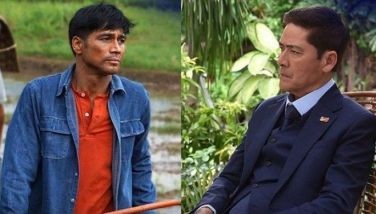Racquel Villavicencio on acting & writing screenplays
MANILA, Philippines - The lady who won the Best Screenplay trophy for Mike de Leon’s Batch ’81, Best Production Design for Ishmael Bernal’s Himala and Best Actress for Jeffrey Jeturian’s Bisperas — is looking for words to describe her more than 30 years in show business.
“It’s masalimuot (complicated) but a happy one as well and quite fulfilling,†Racquel Villavicencio finally finds the words. “On the whole, I like the work in showbiz because I am able to test my own creativity. Showbiz is not boring. I can work as actor, writer and production designer and see finished projects that I know will find their way in local film history.â€
After three decades in showbiz, she has remained slim, tall and gracious, and oblivious of her achievements. In our recent encounter, she had just written the screenplay for TV5’s Bawat Sandali.
According to her, Bawat Sandali, megged by Joel Lamangan with Eric Quizon, was a very complex story to write, compounded by lots of location requirements and then the take-over from one director to another. Eric started it but due to some urgent assignments abroad, Joel took over. Racquel recalls, “Hence, we have to adjust everything from script revisions to new shooting requirements.â€
But work is good as half-done when she works with someone who directs and acts as well. Recalling her working relationship with Joel, she shares, “Direk Joel and I have gone a long way since our early TV and Viva Spotlight days. I worked with him as production designer in Huling Birhen Sa Lupa. I would say there is better rapport when you work with someone who also acts. You can easily discuss role interpretation with him and we can discuss different approaches without encroaching on his roles as director.â€
Another director, Mac Alejandre, describes Racquel as second to none as screenwriter, unquestionable as a friend and artist and yes, an unquestionable beauty in her own way.
Meanwhile, Racquel traces her showbiz inclinations as way far back when she started appearing in school plays in Maryknoll (now Miriam College). By then, her first love was writing and was dabbling in short stories before screenwriting beckoned.
After college in the early ’70s, she worked as secretary at the Asian Institute of Management where action director Jun Cabrera gave her a cameo role as office receptionist with a police station setting. The director noticed her long legs and a few days later, she got another call to play the part of a nurse with Liza Lorena.
Another role, a Mama-san, followed and the rest is history.
She took up a writing workshop at the old LVN studio and director Mike de Leon discovered her. “Mike (de Leon) noticed I can write and later asked me if I can co-write a comedy film with him. This was his comeback film after a long hiatus after Mangarap Ka’t Magising.â€
Needless to say, she learned a lot from De Leon. “We have a very good tolerance for long working hours and he will really pick your brain all night to late in the morning. We discuss our ideas, exchange inputs and divide the writing jobs. He would assign me scenes one to 12 and another one would write scenes 13 to 20. When the whole film was finished, it really looked like it was written by just one person.â€
Within three decades of that writing and acting life including production design, she has worked with the best such as Lino Brocka, Ishmael Bernal, Marilou Diaz-Abaya and Carlitos Siguion-Reyna, among others.
Her impressions vary. “Lino (Brocka) is very respectful of writer’s output. He won’t start a film project if he doesn’t like the script. Thus, he shoots totally faithful to the original script. I worked with him in Makiusap Ka Sa Diyos which Ishma (Bernal) turned down because of its religious subject. Carlitos (Siguion-Reyna) is very meticulous with scripts down to the last period or comma. He won’t shoot until the script is fine-tuned to the last detail.â€
For those who want to follow her screenwriting life, her advice is sparse and to the point. “A must is imagination,†she begins. “Second is you must be able to adjust your writing ability to the needs of the film or TV medium. Let’s face it, some writers are not meant to be good screenwriters inasmuch as screenwriters don’t make good novelists. You have to be a good observer of people and events and a good interpreter as well. If you need to dig into your own life, do it. Those who write mechanically without involvement end up with a technically polished story but with no heart.â€
She points out those who want to be production designers should have a good eye for details from costumes to the location of the movie. “Everything that you see onscreen is details decided by the production designer. Your design should follow the film’s theme to the point of being obsessive-compulsive. You should follow a character down to her or his last attire down to the last buttons. You must also decide the look of the house where he or she is staying. That is how much power you have over the entire look of the film.â€
As actor, she goes by her own tested rule.
She concludes: “To be an effective actor, I only go by one rule in acting and that is in our language, Magpakatotoo ka (Be real). The more you try to act like somebody else, the more it will show. In other words, no acting please.â€
- Latest
- Trending




























